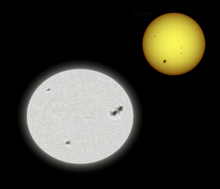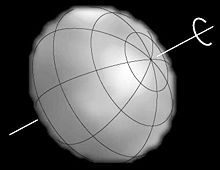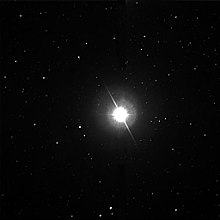Altair
| Observation data ICRS )
| |
|---|---|
| Constellation | Aquila |
Pronunciation
|
/ˈæltɛər/, /ˈæltaɪər/[1][2] |
| Right ascension | 19h 50m 46.99855s[3] |
| Declination | +08° 52′ 05.9563″[3] |
| Apparent magnitude (V) | 0.76[4] |
| Characteristics | |
| Evolutionary stage | Main sequence |
| Spectral type | A7Vn[5] |
| U−B color index | +0.09[4] |
| B−V color index | +0.22[4] |
| V−R color index | +0.14[4] |
| R−I color index | +0.13[4] |
| Variable type | Delta Scuti[6] |
| Absolute magnitude (MV) | 2.22[6] |
| Details | |
Myr | |
| Database references | |
| SIMBAD | data |
Altair is the brightest
Altair rotates rapidly, with a velocity at the
Nomenclature

α Aquilae (Latinised to Alpha Aquilae) is the star's Bayer designation. The traditional name Altair has been used since medieval times. It is an abbreviation of the Arabic phrase النسر الطائر Al-Nisr Al-Ṭa'ir, "the flying eagle".[21]
In 2016, the
Physical characteristics

Along with
Altair is a

Satellite measurements made in 1999 with the Wide Field Infrared Explorer showed that the brightness of Altair fluctuates slightly, varying by just a few thousandths of a magnitude with several different periods less than 2 hours.[6] As a result, it was identified in 2005 as a Delta Scuti variable star. Its light curve can be approximated by adding together a number of sine waves, with periods that range between 0.8 and 1.5 hours.[6] It is a weak source of coronal X-ray emission, with the most active sources of emission being located near the star's equator. This activity may be due to convection cells forming at the cooler equator.[19]
Rotational effects

The angular diameter of Altair was measured
Theory predicts that, owing to Altair's rapid rotation, its
Altair is one of the few
Etymology, mythology and culture

The term Al Nesr Al Tair appeared in
The
In Chinese belief, the asterism consisting of Altair, β Aquilae and γ Aquilae is known as Hé Gǔ (河鼓; lit. "river drum").
The people of Micronesia called Altair Mai-lapa, meaning "big/old breadfruit", while the Māori people called this star Poutu-te-rangi, meaning "pillar of heaven".[37]
In Western astrology, the star was ill-omened, portending danger from reptiles.[30]
This star is one of the asterisms used by Bugis sailors for navigation, called bintoéng timoro, meaning "eastern star".[38]
A group of Japanese scientists sent a radio signal to Altair in 1983 with the hopes of contacting extraterrestrial life.[39]
NASA announced Altair as the name of the
Visual companions
The bright primary
| Component | Primary | J2000.0 |
J2000.0 |
Epoch of observed separation |
Angular distance from primary |
Position angle (relative to primary) |
Apparent magnitude (V) |
Database reference |
|---|---|---|---|---|---|---|---|---|
| B | A | 19h 50m 40.5s | +08° 52′ 13″[43] | 2015 | 195.8 ″ |
286° | 9.8 | SIMBAD |
| C | A | 19h 51m 00.8s | +08° 50′ 58″[44] | 2015 | 186.4 ″ |
110° | 10.3 | SIMBAD |
| D | A | 2015 | 26.8 ″ |
105° | 11.9 | |||
| E | A | 2015 | 157.3 ″ |
354° | 11.0 | |||
| F | A | 19h 51m 02.0s | +08° 55′ 33″ | 2015 | 292.4 ″ |
48° | 10.3 | SIMBAD |
| G | A | 2015 | 185.1 ″ |
121° | 13.0 |
See also
- Lists of stars
- List of brightest stars
- List of nearest bright stars
- Historical brightest stars
- List of most luminous stars
Notes
References
- ^ "Altair: definition of Altair in Oxford dictionary (American English)". Archived from the original on May 12, 2014.
- ^ ISBN 978-1-931559-44-7.
- ^ S2CID 18759600
- ^ Bibcode:2002yCat.2237....0D.
- S2CID 119417105.
- ^ S2CID 16524681.
- ^ a b c NAME ALTAIR -- Variable Star of delta Sct type, database entry, SIMBAD. Accessed on line November 25, 2008.
- ^ S2CID 208857428.
- ^ S2CID 18683397. See Table 2 for stellar parameters.
- Bibcode:1990A&AS...85.1015M
- ^ S2CID 4615273. See second column of Table 1 for stellar parameters.
- CDS ID V/50. Accessed on line November 25, 2008.
- ^ a b c Entry 19508+0852, The Washington Double Star Catalog Archived 2009-01-31 at the Wayback Machine, United States Naval Observatory. Accessed online November 25, 2008.
- ^ David Darling. "Altair". The Internet Encyclopedia of Science. Retrieved 2022-08-03.
- ^ Darling, David. "Summer Triangle". www.daviddarling.info. Retrieved 2008-11-26.
- ^ OCLC 440257051.
- ^ "Our Local Galactic Neighborhood". NASA. Archived from the original on 2013-11-21.
- ^ Gilster, Paul (2010-09-01). "Into the Interstellar Void". Centauri Dreams. Retrieved 2017-03-26.
- ^ S2CID 14320453.
- ^ S2CID 13969695.
- ^ "the definition of altair". www.dictionary.com. Retrieved 2018-09-30.
- ^ "IAU Working Group on Star Names (WGSN)". Retrieved 22 May 2016.
- ^ "Bulletin of the IAU Working Group on Star Names, No. 1" (PDF). Archived (PDF) from the original on 2022-10-09. Retrieved 28 July 2016.
- ^ "IAU Catalog of Star Names". Retrieved 28 July 2016.
- .
- S2CID 15857535.
- .
- ^ a b "Gazing up at the Man in the Star?" (Press release). National Science Foundation. May 31, 2007. Retrieved 2022-08-03.
- .
- ^ a b c Allen, Richard Hinckley (1899). Star-names and their meanings. unknown library. New York, Leipzig [etc.] G.E. Stechert. pp. 59–60.
- S2CID 84102853.
- ^ ISBN 1-85538-306-3.
- ^ (in Chinese) 香港太空館 - 研究資源 - 亮星中英對照表 Archived 2008-10-25 at the Wayback Machine, Hong Kong Space Museum. Accessed on line November 26, 2008.
- ^ Mayers, William Frederick (1874). The Chinese reader's manual: A handbook of biographical, historical ... Harvard University. American Presbyterian Mission Press. pp. 97–98, 161.
- ^ ISBN 978-1-4196-4893-9.
- ISBN 978-1-59158-294-6.
- ISBN 978-1-921313-19-6.
- ISBN 978-1-4419-7623-9.
- ^ "'Anybody there?' Astronomers waiting for a reply from Altair". August 20, 2023. Retrieved 2023-08-25.
- ^ "NASA names next-gen lunar lander Altair". .collectSPACE. December 13, 2007. Retrieved 2022-08-03.
- Beriev Aircraft Company. February 12, 2003. Archived from the originalon 2021-11-05. Retrieved 2022-08-03.
- .
- ^ BD+08 4236B -- Star in double system, database entry, SIMBAD. Accessed online November 25, 2008.
- ^ BD+08 4238 -- Star in double system, database entry, SIMBAD. Accessed online November 25, 2008.
External links
- Star with Midriff Bulge Eyed by Astronomers, JPL press release, July 25, 2001.
- Spectrum of Altair
- Imaging the Surface of Altair, University of Michigan news release detailing the CHARA array direct imaging of the stellar surface in 2007.
- PIA04204: Altair, NASA. Image of Altair from the Palomar Testbed Interferometer.
- Altair, SolStation.
- Secrets of Sun-like star probed, BBC News, June 1, 2007.
- Astronomers Capture First Images of the Surface Features of Altair Archived 2009-06-29 at the Wayback Machine, Astromart.com
- Image of Altair from Aladin.

